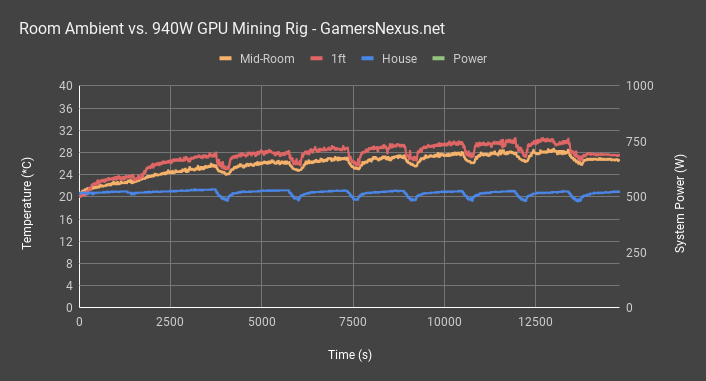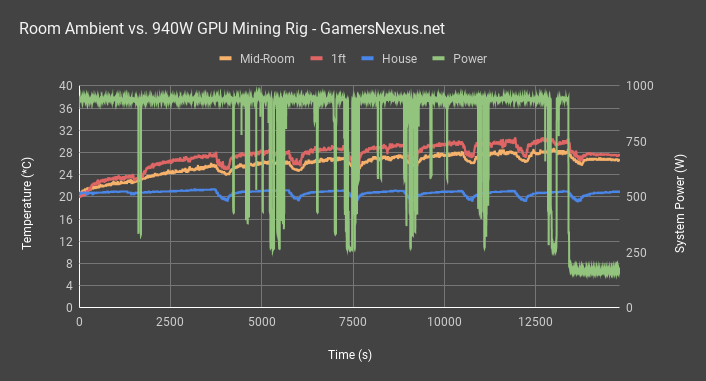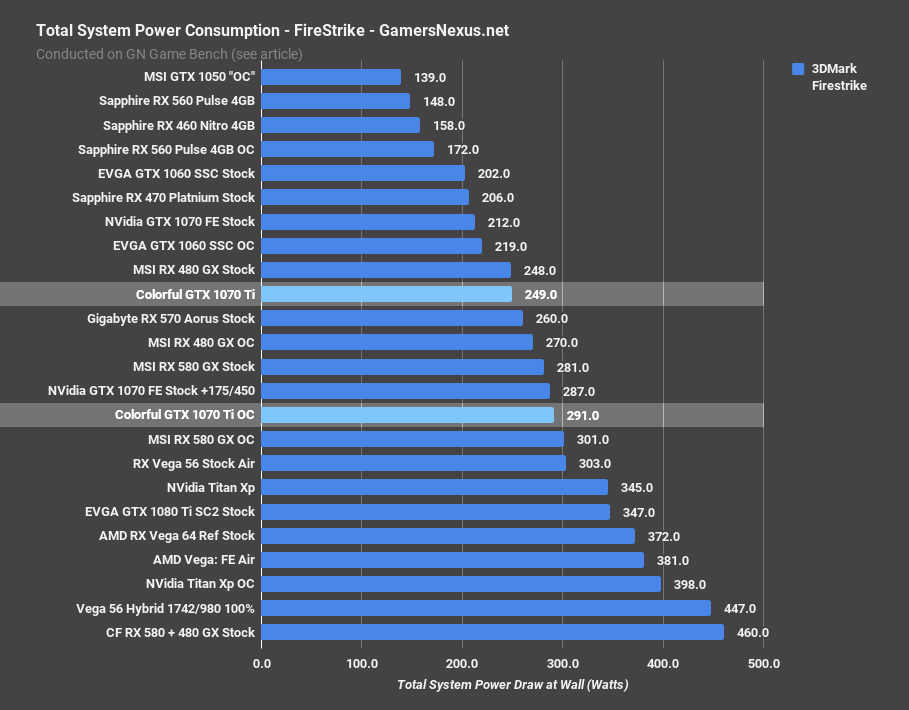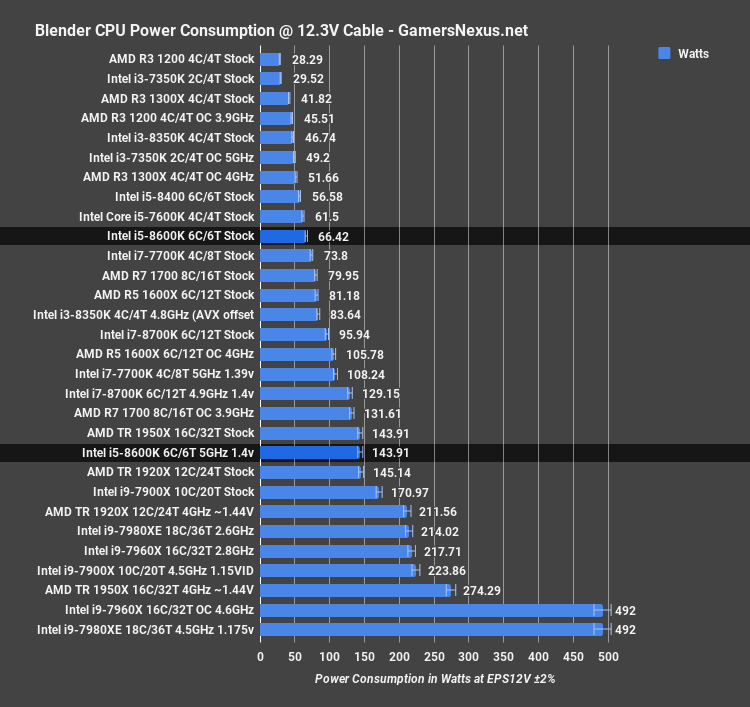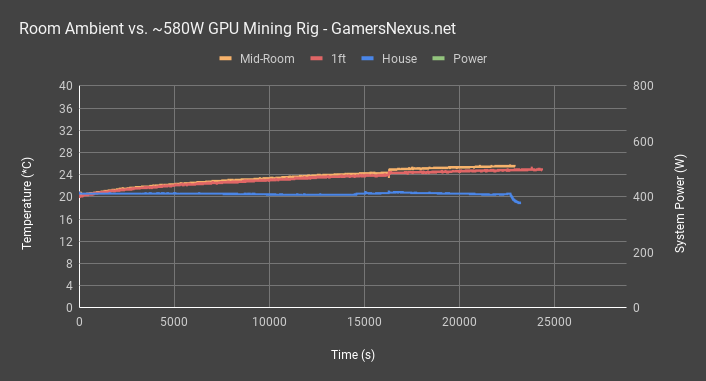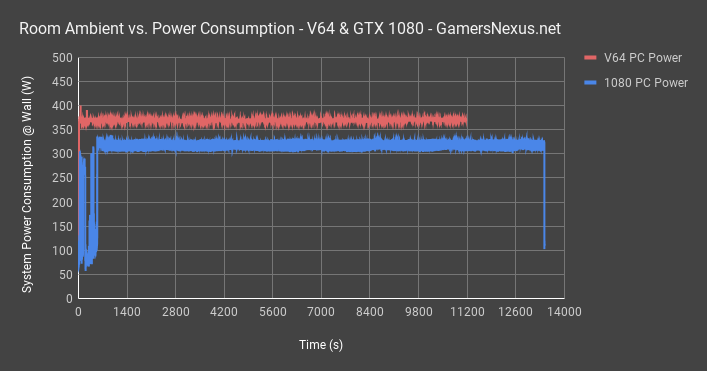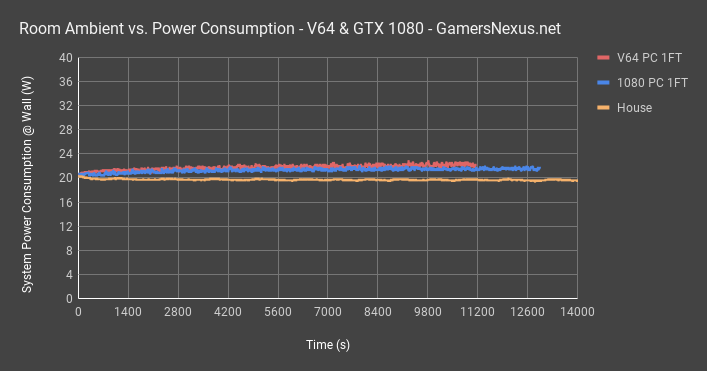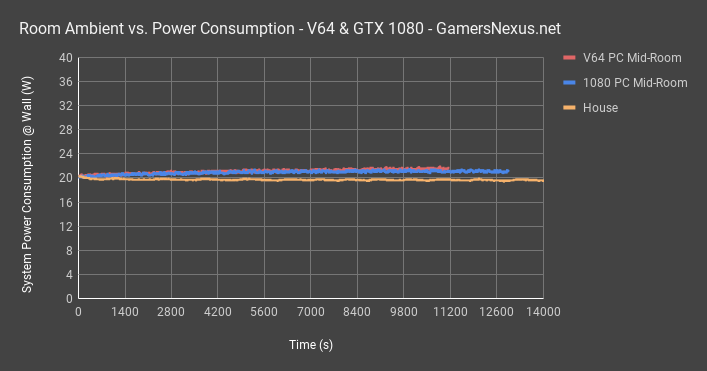Vega 64 may consume more power than a GTX 1080, but until now, we haven’t known if that impact is relevant to room temperature. That’s what we wanted to know, and we eventually expanded that concept to include how much a 900W+ mining machine increases room temperature, a 600W machine, and so on. We were able to effectively replace any need of a heater for the past week, and right when it started to get colder.
In this test, we’re looking at the room ambient impact of various PC builds. This helps to conceptualize the real-world impact of all those power and thermal tests you see us (and others) publish, as it puts real numbers to the user experience outside of the case. Although this concept has about a million variables and “what ifs,” we controlled to the best of our abilities, are laying-out all the major variables, and can present an academic experiment that demonstrates room temperature increase from computer equipment. All watts are basically created equal, for the purposes of this test: A 940W mining rig will output just as much heat into the room as a 940W gaming rig, or a 940W rendering machine, and so forth; as long as the power load is equal between all of these (read: constant), watts are watts, and you can extrapolate room temperature for each type of machine.
The testing originally was concepted after our Vega 56 Hybrid mod, which used power mods and other mods to push the card up towards 400W of power consumption. We wanted to test a straight Vega 56 versus GTX 1070 for room ambient impact, but shifted that up a tier (to Vega 64 and a GTX 1080) for some parts that are more likely to show a difference. After that, we shifted up to a 940W mining machine, then picked a middle-ground ~600W machine (which could also represent SLI gaming or HEDT render systems).
Imperfect Testing & Decision Points: Thermal Chambers vs. Bedrooms
These tests are imperfect, and although we can control to a degree, it is impossible to control all variables. We had considered using the thermal chambers that we’ve used in the past, but those are about big enough for one human to stand in – it wouldn’t give us data we could extrapolate to a bedroom-sized room. Such a chamber would exacerbate the differences, heat up faster, and doesn’t use the materials that a house bedroom uses, and so we ditched the idea. Instead of using a small thermal chamber, we moved the testing to our video set, which is functionally a bedroom.
This means we have four walls, insulation, a door with a small gap underneath, a ceiling fan, and some basic furniture (three wooden tables, a chair, some shelves, a tool wall, etc.). For room setup, we configured the ceiling fan to spin at its medium setting and left the 60W ceiling light on, as this will generate a minor amount of additional heat. The idea is that a user who’s trying to combat rising room temperature would likely have the fan on, and you’ll probably have the light on.
We considered blocking the underside of the door with a wet towel, which would help isolate the test, but ultimately decided against it: Controlling to that degree doesn’t help us much, since we’re still fighting other uncontrollable variables, and it exits reality.
We ran all tests on different days, giving the room time to cool down between each test. This test took a few weeks to run, as we waited for similar or identical outside weather and temperature conditions to run each test. As for AC, we considered disabling it entirely, but ultimately decided to configure AC to regulate a temperature of 70F, or 21C, for the 900W+ test. AC was left largely off for the other tests. This was primarily for fire hazard concerns. We did not want the 940W machine to operate in 40C ambient, as heat causes fire, and we were running things borderline spec to begin with.
Here’s the next challenge: The thermostat is located in the hallway, just outside this room, so its sensor won’t trip unless things start getting really warm and seeping out from under the door. We placed a thermocouple down the hall and in the coldest room in the house, which let us monitor uninfluenced ambient temperatures. Size of the room under test is about 15’-4 by 9’-9. We’re measuring temperature every second over a period of several hours. Some tests went on for as long as 7 hours and were still not at steady state, just to give an idea. The thermocouples were positioned 1ft away from the PC, basically where you’d be sitting, in the middle of the room, and in another room altogether (control).
The point of all of this is to highlight that this is a highly imperfect test, but it is an academic one, and one which yields interesting results and gives you an idea of how things behave. Of course, your house alone will hugely dictate how all of this behaves, as would your AC policy, your insulation, external temperature, and so on. But we’re able to somewhat control for our environment, so in the very least, we can study behavior in just one environment.
Seemingly small things, like keeping the door closed, can have a big impact on the tests. Depending on how you’d do it at home, your results will vary. Opening the door would help a huge amount, for instance, and we’ll talk about that at the end.
Component lists aren’t all that important, as power is just power. That said, we’ll define most of them as we go. The power supply is the only primarily important unit, as it will dictate efficiency after the wall – we used a Thermaltake Toughpower Gold unit at 1200W capacity.
940W Mining Machine vs. Room Temperature
We’re starting with the most extreme experiment, since that one’s kind of fun to look at. This is from our 940W temporary mining machine, which used a mixture of 4x GTX 1080 and 1080 Ti GPUs; we had three GTX 1080 Tis and one GTX 1080, all configured to 70% power limits with 100-150MHz core overclocks and 250MHz memory underclocks. We have the TR1950X at 4.0GHz and 1.35VCore. The fans were also blasting, and we had a few fans positioned on the tables to reduce heat in key locations. The idea was to avoid burning down the house. While all these were going, we also had the CPU burning for CryptoNight, for which we used a 1950X under the Liqtech 360mm cooler. Power sat at around 940W at the wall, all said and done.
For results, here’s what we got: Room ambient for this test started at around 20 degrees Celsius, with our control room at around 20.4 degrees. At one foot of distance, the room temperature increases by 5 degrees within half an hour, keeping the door closed, with temperatures at the one-hour mark climbing to 27.5 degrees. For those using Fahrenheit, that’d be a climb from about 69F to about 81.5F in the span of an hour. Our AC kicks in at this point and regulates the control room and hallway down to the target, which briefly drops temperatures by about 1.5 degrees in the test room. Between AC cycles, we manage to climb all the way up to about 30 degrees Celsius, following three hours of testing, and that’s while AC is battling the temperature rise. In Fahrenheit, that puts us at 86 degrees, effectively eliminating the need for heating in the room during winter; actually, it basically necessitates AC.
Middle of room temperatures aren’t quite as bad as being in the “combat seat,” with a maximum temperature of about 28.1 degrees.
As for power consumption, the chart’s about to get messy: This green line, mapped to the right axis, represents power consumption during the test. This machine was running Nicehash, back before it was hacked, and that’s what loaded the rig fairly evenly for testing.
If you had a similar room setup to ours – a bedroom that is attached to HVAC and has its door closed – you’re looking at high room temperatures. We went 5 degrees over control in just half an hour, and reached 9 degrees over in about 3 hours.
~600W Machine vs. Room Ambient Temperature
This next test is closer to a high-end gaming or production machine, and consumes about 600W of power.
Looking at this Firestrike chart from our GTX 1070 Ti review, we can see that a CrossFire configuration was pulling about 460W for the system, with our power-modded Vega 56 at 447W for the system. A 600W machine would be similar to running two 1080 Tis at full tilt, or running an overclocked i9 CPU with a high-end GPU.
This chart from our 7980XE review helps reinforce that: It’s not too hard to make CPUs draw 500W alone, as these CPU power charts show consumption at the rails.
Knowing that, our next test at 600W is a bit more achievable, but still on the high side.
This machine progresses somewhat linearly, as the temperature never reached a point of tripping the AC target in the hallway. The 900W machine had just enough heat seeping into the hallway that AC triggered more frequently, and so this test, once again, shows its imperfections and limited control. That said, it’s a good look at how room temperature behaves when left uncontested by AC, and this is all ultimately experimental, not comparative, anyway.
With no AC to help out, the room temperature starts at about 20 degrees Celsius for all of our probes, reaching only 21 degrees after half an hour, so no big deal. By the one-hour point, we’re at 22 degrees. Temperature still hadn’t reached steady state by the end, though, and so we allowed the test to run for 7 full hours. At the end of all this, we’re at 25.6 degrees and climbing higher, as it’s still not perfectly steady state. That said, 7 hours is a long time to run a machine at full tilt. Keeping with our theme of realism, if you’re running a machine at 600W for 7 hours, you’re probably rendering or encoding something, and that means you can probably exit the room.
Vega 64 vs. GTX 1080 Room Temperature Impact
Our final test is the one that prompted all of this: We all know Vega is power hungry when compared to a GTX 1070 or GTX 1080, but the question is whether or not that factors in to room temperature. Again, this test doesn’t apply to all rooms, but it’ll give us an idea for an average American bedroom.
This test was a looping Firestrike benchmark for a few hours. Here’s the power consumption chart:
The Vega 64 system consumed about 360-380W on average, where the GTX 1080 system consumed 300 to 330W on average.
This 50W peak-to-peak amplitude manifests itself minimally in room thermals, as you can see in this chart of temperature from the chair, at a 1-foot distance. After a few hours, the Vega 64 card heated our room up by about an additional 1-1.25 degrees over the GTX 1080 card. Given the inherently difficult nature of controlling this testing, we can write this off as functionally equal. It’d start mattering as you stacked more and more cards, but with single-card gaming machine under gaming workloads, it’s just not showing up. This is also without AC ever triggering to turn on, as there wasn’t enough of a temperature change to fire. If the room were smaller, we had more machines running, or it were already hot outside, this might be more noticeable.
Our chart of temperatures from the middle of the room shows largely the same, though the temperatures are even closer as we get farther from the PC.
Conclusion
Again, these tests are controlled for as much as is reasonable, but they don’t necessarily apply to your own rooms. That said, we can understand practical, real-world impact from PC build power consumption as it relates to room temperature. All of these tests were conducted with the controls (and variables) laid-out in the first few paragraphs. Breaking objective tone momentarily and speaking subjectively, opening the door (it was left closed for testing) improved temperature noticeably to the user. In worst case scenarios, we could keep room ambient about 3C lower with the door opened, and opening windows or increasing ceiling fan speed would also help. The point is, there’s a lot you can do to try and mitigate room temperature increase from high-wattage rendering, gaming, or mining PCs. Even still, room temperature will increase with that door open in a somewhat linear fashion when compared to the other tests. More power is going to create more heat, period, it’s just a matter of how effectively you can get it out of the room.
As for the Vega 64 versus GTX 1080 comparison, the temperature difference wasn’t large – and we’re not comfortable stating whether it’s appreciable, as enough variables exist to potentially call a 1-degree difference as nearly within or within margins. In the tested bedroom, they are functionally the same for room temperature increase when tested in our 7700K @ 4.5GHz standard system. Comparing two single-card solutions won’t really generate enough of a power load to show appreciable differences in most average-sized American bedrooms, we think, as the heat has enough space to dissipate. It’s when you start moving toward multi-card gaming, rendering, or mining machines that it’ll matter, or going to overclocked HEDT CPUs that are running long uptime renders.
Let us know if you have similar ideas for experiments like this one.
Editorial, Testing: Steve Burke
Video: Andrew Coleman
